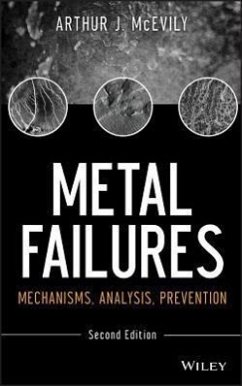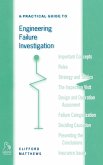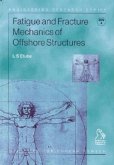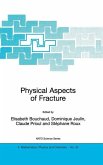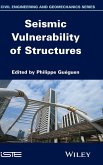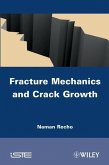- Gebundenes Buch
- Merkliste
- Auf die Merkliste
- Bewerten Bewerten
- Teilen
- Produkt teilen
- Produkterinnerung
- Produkterinnerung
Comprehensive coverage of both the "how" and "why" of metal failures--revised and updated Metal Failures has become a classic engineering resource known for its concise and authoritative treatment of both the mechanisms of metal failure and the examination methods used to determine the reasons for failure. This Second Edition has been updated throughout, and features new or expanded coverage of topics including elastic behavior and plastic deformation, localized necking, the phenomenological aspects of fatigue, fatigue crack propagation, the staircase method, alloys and coatings, tensors, and…mehr
Andere Kunden interessierten sich auch für
![A Practical Guide to Engineering Failure Investigation A Practical Guide to Engineering Failure Investigation]() Clifford MatthewsA Practical Guide to Engineering Failure Investigation262,99 €
Clifford MatthewsA Practical Guide to Engineering Failure Investigation262,99 €![Fatigue and Fracture Mechanics of Offshore Structures Fatigue and Fracture Mechanics of Offshore Structures]() Linus EtubeFatigue and Fracture Mechanics of Offshore Structures187,99 €
Linus EtubeFatigue and Fracture Mechanics of Offshore Structures187,99 €![Mechanical Behavior of Concrete Mechanical Behavior of Concrete]() Mechanical Behavior of Concrete262,99 €
Mechanical Behavior of Concrete262,99 €![Fatigue of Materials and Structures Fatigue of Materials and Structures]() Fatigue of Materials and Structures190,99 €
Fatigue of Materials and Structures190,99 €![Physical Aspects of Fracture Physical Aspects of Fracture]() Elisabeth BouchaudPhysical Aspects of Fracture104,99 €
Elisabeth BouchaudPhysical Aspects of Fracture104,99 €![Seismic Vulnerability of Structures Seismic Vulnerability of Structures]() Philippe GueguenSeismic Vulnerability of Structures180,99 €
Philippe GueguenSeismic Vulnerability of Structures180,99 €![Fracture Mechanics and Crack Growth Fracture Mechanics and Crack Growth]() Naman RechoFracture Mechanics and Crack Growth289,99 €
Naman RechoFracture Mechanics and Crack Growth289,99 €-
-
-
Comprehensive coverage of both the "how" and "why" of metal failures--revised and updated Metal Failures has become a classic engineering resource known for its concise and authoritative treatment of both the mechanisms of metal failure and the examination methods used to determine the reasons for failure. This Second Edition has been updated throughout, and features new or expanded coverage of topics including elastic behavior and plastic deformation, localized necking, the phenomenological aspects of fatigue, fatigue crack propagation, the staircase method, alloys and coatings, tensors, and tensor notations. The analytical methods presented in the book include stress analysis, fracture mechanics, fatigue analysis, corrosion science, and nondestructive testing. Numerous case studies illustrate the application of basic principles of metallurgy and failure analysis to a wide variety of real-world situations. Sample problems and solutions are also provided to help bridge the gap between theory and application. Readers learn how to investigate and analyze failures that involve: * Alloys and coatings * Thermal and residual stresses * Corrosion and cracking * Brittle and ductile fractures * Creep and fatigue * Friction and wear The proven methods of examination and analysis presented in this book enable investigators to conduct successful investigations of the causes of metal failures that may lead to design or manufacturing improvements that prevent future failures. Metal Failures, Second Edition is an excellent learning tool for senior-level students in mechanical, materials, aerospace, and civil engineering, as well as for professionals involved in metal failure analysis.
Hinweis: Dieser Artikel kann nur an eine deutsche Lieferadresse ausgeliefert werden.
Hinweis: Dieser Artikel kann nur an eine deutsche Lieferadresse ausgeliefert werden.
Produktdetails
- Produktdetails
- Verlag: Wiley
- 2nd Revised edition
- Seitenzahl: 496
- Erscheinungstermin: 16. September 2013
- Englisch
- Abmessung: 241mm x 159mm x 32mm
- Gewicht: 794g
- ISBN-13: 9781118163962
- ISBN-10: 1118163966
- Artikelnr.: 36908321
- Herstellerkennzeichnung
- Libri GmbH
- Europaallee 1
- 36244 Bad Hersfeld
- gpsr@libri.de
- Verlag: Wiley
- 2nd Revised edition
- Seitenzahl: 496
- Erscheinungstermin: 16. September 2013
- Englisch
- Abmessung: 241mm x 159mm x 32mm
- Gewicht: 794g
- ISBN-13: 9781118163962
- ISBN-10: 1118163966
- Artikelnr.: 36908321
- Herstellerkennzeichnung
- Libri GmbH
- Europaallee 1
- 36244 Bad Hersfeld
- gpsr@libri.de
ARTHUR J. McEVILY, DEngSc, is Professor Emeritus in the Department of Metallurgy and Materials Engineering at the University of Connecticut.
Preface xv
1. Failure Analysis 1
I. Introduction 1
II. Examples of Case Studies Involving Structural Failures 6
III. Summary 25
References 25
Problems 26
2. Elements of Elastic Deformation 27
I. Introduction 27
II. Stress 27
III. Strain 32
IV. Elastic Constitutive Relationships 35
V. State of Stress Ahead of a Notch 44
VI. Summary 46
References 46
Appendix 2-1: Mohr Circle Equations for a Plane Problem 46
Appendix 2-2: Three-Dimensional Stress Analysis 49
Appendix 2-3: Stress Formulas Under Simple Loading Conditions 54
Problems 57
3. Elements of Plastic Deformation 59
I. Introduction 59
II. Theoretical Shear Strength 59
III. Dislocations 61
IV. Yield Criteria for Multiaxial Stress 68
V. State of Stress in the Plastic Zone Ahead of a Notch in Plane-Strain
Deformation 70
VI. Summary 74
For Further Reading 75
Appendix 3-1: The von Mises Yield Criterion 75
Problems 76
4. Elements of Fracture Mechanics 80
I. Introduction 80
II. Griffith's Analysis of the Critical Stress for Brittle Fracture 80
III. Alternative Derivation of the Griffith Equation 83
IV. Orowan-Irwin Modification of the Griffith Equation 84
V. Stress Intensity Factors 85
VI. The Three Loading Modes 88
VII. Determination of the Plastic Zone Size 88
VIII. Effect of Thickness on Fracture Toughness 89
IX. The R-Curve 91
X. Short Crack Limitation 92
XI. Case Studies 92
XII. The Plane-Strain Crack Arrest Fracture Toughness, K I a, of Ferritic
Steels 95
XIII. Elastic-plastic Fracture Mechanics 96
XIV. Failure Assessment Diagrams 98
XV. Summary 101
References 101
Problems 102
5. Alloys and Coatings 105
I. Introduction 105
II. Alloying Elements 106
III. Periodic Table 107
IV. Phase Diagrams 108
V. Coatings 126
VI. Summary 130
References 130
Problems 130
6. Examination and Reporting Procedures 132
I. Introduction 132
II. Tools for Examinations in the Field 132
III. Preparation of Fracture Surfaces for Examination 133
IV. Visual Examination 133
V. Case Study: Failure of a Steering Column Component 134
VI. Optical Examination 135
VII. Case Study: Failure of a Helicopter Tail Rotor 136
VIII. The Transmission Electron Microscope (TEM) 136
IX. The Scanning Electron Microscope (SEM) 138
X. Replicas 142
XI. Spectrographic and Other Types of Chemical Analysis 143
XII. Case Study: Failure of a Zinc Die Casting 144
XIII. Specialized Analytical Techniques 145
XIV. Stress Measurement by X-Rays 146
XV. Case Study: Residual Stress in a Train Wheel 149
XVI. The Technical Report 150
XVII. Record Keeping and Testimony 151
XVIII. Summary 154
References 155
Problem 155
7. Brittle and Ductile Fractures 156
I. Introduction 156
II. Brittle Fracture 156
III. Some Examples of Brittle Fracture in Steel 159
IV. Ductile-Brittle Behavior of Steel 161
V. Case Study: The Nuclear Pressure Vessel Design Code 168
VI. Case Study: Examination of Samples from the Royal Mail Ship (RMS)
Titanic 172
VII. Ductile Fracture 177
VIII. Ductile Tensile Failure, Necking 177
IX. Fractographic Features Associated with Ductile Rupture 183
X. Failure in Torsion 185
XI. Case Study: Failure of a Helicopter Bolt 185
XII. Summary 188
References 191
Problems 191
8. Thermal and Residual Stresses 196
I. Introduction 196
II. Thermal Stresses, Thermal Strain, and Thermal Shock 196
III. Residual Stresses Caused by Nonuniform Plastic Deformation 200
IV. Residual Stresses Due to Quenching 204
V. Residual Stress Toughening 207
VI. Residual Stresses Resulting from Carburizing, Nitriding, and Induction
Hardening 207
VII. Residual Stresses Developed in Welding 209
VIII. Measurement of Residual Stresses 211
IX. Summary 211
References 211
Appendix 8-1: Case Study of a Fracture Due to Thermal Stress 212
Problems 213
9. Creep 216
I. Introduction 216
II. Background 216
III. Characteristics of Creep 217
IV. Creep Parameters 220
V. Creep Fracture Mechanisms 222
VI. Fracture Mechanism Maps 224
VII. Case Studies 225
VIII. Residual Life Assessment 230
IX. Stress Relaxation 232
X. Elastic Follow-up 233
XI. Summary 234
References 234
Problems 234
10. Fatigue 237
I. Introduction 237
II. Background 237
III. Design Considerations 240
IV. Mechanisms of Fatigue 246
V. Factors Affecting Fatigue Crack Initiation 254
VI. Factors Affecting Fatigue Crack Growth 257
VII. Analysis of the Rate of Fatigue Crack Propagation 261
VIII. Fatigue Failure Analysis 273
IX. Case Studies 276
X. Thermal-Mechanical Fatigue 285
XI. Cavitation 285
XII. Composite Materials 286
XIII. Summary 287
References 287
For Further Reading 290
Problems 290
11. Statistical Distributions 293
I. Introduction 293
II. Distribution Functions 293
III. The Normal Distribution 294
IV. Statistics of Fatigue; Statistical Distributions 296
V. The Weibull Distribution 298
VI. The Gumbel Distribution 302
VII. The Staircase Method 307
VIII. Summary 310
References 310
Appendix 11-1: Method of Linear Least Squares (C. F. Gauss, 1794) 311
Problems 314
12. Defects 316
I. Introduction 316
II. Weld Defects 316
III. Case Study: Welding Defect 321
IV. Casting Defects 328
V. Case Study: Corner Cracking during Continuous Casting 329
VI. Forming Defects 329
VII. Case Studies: Forging Defects 330
VIII. Case Study: Counterfeit Part 332
IX. The Use of the Wrong Alloys; Errors in Heat Treatment, etc. 333
X. Summary 334
References 334
Problems 334
13. Environmental Effects 336
I. Introduction 336
II. Definitions 336
III. Fundamentals of Corrosion Processes 337
IV. Environmentally Assisted Cracking Processes 342
V. Case Studies 348
VI. Cracking in Oil and Gas Pipelines 350
VII. Crack Arrestors and Pipeline Reinforcement 352
VIII. Plating Problems 353
IX. Case Studies 353
X. Pitting Corrosion of Household Copper Tubing 356
XI. Problems with Hydrogen at Elevated Temperatures 356
XII. Hot Corrosion (Sulfidation) 358
XIII. Summary 358
References 358
Problems 359
14. Flaw Detection 360
I. Introduction 360
II. Inspectability 360
III. Visual Examination (VE) 364
IV. Penetrant Testing (PT) 364
V. Case Study: Sioux City DC-10 Aircraft 367
VI. Case Study: MD-88 Engine Failure 374
VII. Magnetic Particle Testing (MT) 375
VIII. Case Study: Failure of an Aircraft Crankshaft 378
IX. Eddy Current Testing (ET) 382
X. Case Study: Aloha Airlines 384
XI. Ultrasonic Testing (UT) 384
XII. Case Study: B747 389
XIII. Radiographic Testing (RT) 389
XIV. Acoustic Emission Testing (AET) 391
XV. Cost of Inspections 393
XVI. Summary 393
References 394
Problems 394
15. Wear 396
I. Wear 396
II. The Coefficient of Friction 397
III. The Archard Equation 398
IV. An Example of Adhesive Wear 399
V. Fretting Fatigue 399
VI. Case Study: Friction and Wear; Bushing Failure 403
VII. Roller Bearings 404
VIII. Case Study: Failure of a Railroad Car Axle 410
IX. Gear Failures 410
X. Summary 414
References 414
Problems 415
Concluding Remarks 417
Solutions to Problems 419
Name Index 469
Subject Index 473
1. Failure Analysis 1
I. Introduction 1
II. Examples of Case Studies Involving Structural Failures 6
III. Summary 25
References 25
Problems 26
2. Elements of Elastic Deformation 27
I. Introduction 27
II. Stress 27
III. Strain 32
IV. Elastic Constitutive Relationships 35
V. State of Stress Ahead of a Notch 44
VI. Summary 46
References 46
Appendix 2-1: Mohr Circle Equations for a Plane Problem 46
Appendix 2-2: Three-Dimensional Stress Analysis 49
Appendix 2-3: Stress Formulas Under Simple Loading Conditions 54
Problems 57
3. Elements of Plastic Deformation 59
I. Introduction 59
II. Theoretical Shear Strength 59
III. Dislocations 61
IV. Yield Criteria for Multiaxial Stress 68
V. State of Stress in the Plastic Zone Ahead of a Notch in Plane-Strain
Deformation 70
VI. Summary 74
For Further Reading 75
Appendix 3-1: The von Mises Yield Criterion 75
Problems 76
4. Elements of Fracture Mechanics 80
I. Introduction 80
II. Griffith's Analysis of the Critical Stress for Brittle Fracture 80
III. Alternative Derivation of the Griffith Equation 83
IV. Orowan-Irwin Modification of the Griffith Equation 84
V. Stress Intensity Factors 85
VI. The Three Loading Modes 88
VII. Determination of the Plastic Zone Size 88
VIII. Effect of Thickness on Fracture Toughness 89
IX. The R-Curve 91
X. Short Crack Limitation 92
XI. Case Studies 92
XII. The Plane-Strain Crack Arrest Fracture Toughness, K I a, of Ferritic
Steels 95
XIII. Elastic-plastic Fracture Mechanics 96
XIV. Failure Assessment Diagrams 98
XV. Summary 101
References 101
Problems 102
5. Alloys and Coatings 105
I. Introduction 105
II. Alloying Elements 106
III. Periodic Table 107
IV. Phase Diagrams 108
V. Coatings 126
VI. Summary 130
References 130
Problems 130
6. Examination and Reporting Procedures 132
I. Introduction 132
II. Tools for Examinations in the Field 132
III. Preparation of Fracture Surfaces for Examination 133
IV. Visual Examination 133
V. Case Study: Failure of a Steering Column Component 134
VI. Optical Examination 135
VII. Case Study: Failure of a Helicopter Tail Rotor 136
VIII. The Transmission Electron Microscope (TEM) 136
IX. The Scanning Electron Microscope (SEM) 138
X. Replicas 142
XI. Spectrographic and Other Types of Chemical Analysis 143
XII. Case Study: Failure of a Zinc Die Casting 144
XIII. Specialized Analytical Techniques 145
XIV. Stress Measurement by X-Rays 146
XV. Case Study: Residual Stress in a Train Wheel 149
XVI. The Technical Report 150
XVII. Record Keeping and Testimony 151
XVIII. Summary 154
References 155
Problem 155
7. Brittle and Ductile Fractures 156
I. Introduction 156
II. Brittle Fracture 156
III. Some Examples of Brittle Fracture in Steel 159
IV. Ductile-Brittle Behavior of Steel 161
V. Case Study: The Nuclear Pressure Vessel Design Code 168
VI. Case Study: Examination of Samples from the Royal Mail Ship (RMS)
Titanic 172
VII. Ductile Fracture 177
VIII. Ductile Tensile Failure, Necking 177
IX. Fractographic Features Associated with Ductile Rupture 183
X. Failure in Torsion 185
XI. Case Study: Failure of a Helicopter Bolt 185
XII. Summary 188
References 191
Problems 191
8. Thermal and Residual Stresses 196
I. Introduction 196
II. Thermal Stresses, Thermal Strain, and Thermal Shock 196
III. Residual Stresses Caused by Nonuniform Plastic Deformation 200
IV. Residual Stresses Due to Quenching 204
V. Residual Stress Toughening 207
VI. Residual Stresses Resulting from Carburizing, Nitriding, and Induction
Hardening 207
VII. Residual Stresses Developed in Welding 209
VIII. Measurement of Residual Stresses 211
IX. Summary 211
References 211
Appendix 8-1: Case Study of a Fracture Due to Thermal Stress 212
Problems 213
9. Creep 216
I. Introduction 216
II. Background 216
III. Characteristics of Creep 217
IV. Creep Parameters 220
V. Creep Fracture Mechanisms 222
VI. Fracture Mechanism Maps 224
VII. Case Studies 225
VIII. Residual Life Assessment 230
IX. Stress Relaxation 232
X. Elastic Follow-up 233
XI. Summary 234
References 234
Problems 234
10. Fatigue 237
I. Introduction 237
II. Background 237
III. Design Considerations 240
IV. Mechanisms of Fatigue 246
V. Factors Affecting Fatigue Crack Initiation 254
VI. Factors Affecting Fatigue Crack Growth 257
VII. Analysis of the Rate of Fatigue Crack Propagation 261
VIII. Fatigue Failure Analysis 273
IX. Case Studies 276
X. Thermal-Mechanical Fatigue 285
XI. Cavitation 285
XII. Composite Materials 286
XIII. Summary 287
References 287
For Further Reading 290
Problems 290
11. Statistical Distributions 293
I. Introduction 293
II. Distribution Functions 293
III. The Normal Distribution 294
IV. Statistics of Fatigue; Statistical Distributions 296
V. The Weibull Distribution 298
VI. The Gumbel Distribution 302
VII. The Staircase Method 307
VIII. Summary 310
References 310
Appendix 11-1: Method of Linear Least Squares (C. F. Gauss, 1794) 311
Problems 314
12. Defects 316
I. Introduction 316
II. Weld Defects 316
III. Case Study: Welding Defect 321
IV. Casting Defects 328
V. Case Study: Corner Cracking during Continuous Casting 329
VI. Forming Defects 329
VII. Case Studies: Forging Defects 330
VIII. Case Study: Counterfeit Part 332
IX. The Use of the Wrong Alloys; Errors in Heat Treatment, etc. 333
X. Summary 334
References 334
Problems 334
13. Environmental Effects 336
I. Introduction 336
II. Definitions 336
III. Fundamentals of Corrosion Processes 337
IV. Environmentally Assisted Cracking Processes 342
V. Case Studies 348
VI. Cracking in Oil and Gas Pipelines 350
VII. Crack Arrestors and Pipeline Reinforcement 352
VIII. Plating Problems 353
IX. Case Studies 353
X. Pitting Corrosion of Household Copper Tubing 356
XI. Problems with Hydrogen at Elevated Temperatures 356
XII. Hot Corrosion (Sulfidation) 358
XIII. Summary 358
References 358
Problems 359
14. Flaw Detection 360
I. Introduction 360
II. Inspectability 360
III. Visual Examination (VE) 364
IV. Penetrant Testing (PT) 364
V. Case Study: Sioux City DC-10 Aircraft 367
VI. Case Study: MD-88 Engine Failure 374
VII. Magnetic Particle Testing (MT) 375
VIII. Case Study: Failure of an Aircraft Crankshaft 378
IX. Eddy Current Testing (ET) 382
X. Case Study: Aloha Airlines 384
XI. Ultrasonic Testing (UT) 384
XII. Case Study: B747 389
XIII. Radiographic Testing (RT) 389
XIV. Acoustic Emission Testing (AET) 391
XV. Cost of Inspections 393
XVI. Summary 393
References 394
Problems 394
15. Wear 396
I. Wear 396
II. The Coefficient of Friction 397
III. The Archard Equation 398
IV. An Example of Adhesive Wear 399
V. Fretting Fatigue 399
VI. Case Study: Friction and Wear; Bushing Failure 403
VII. Roller Bearings 404
VIII. Case Study: Failure of a Railroad Car Axle 410
IX. Gear Failures 410
X. Summary 414
References 414
Problems 415
Concluding Remarks 417
Solutions to Problems 419
Name Index 469
Subject Index 473
Preface xv
1. Failure Analysis 1
I. Introduction 1
II. Examples of Case Studies Involving Structural Failures 6
III. Summary 25
References 25
Problems 26
2. Elements of Elastic Deformation 27
I. Introduction 27
II. Stress 27
III. Strain 32
IV. Elastic Constitutive Relationships 35
V. State of Stress Ahead of a Notch 44
VI. Summary 46
References 46
Appendix 2-1: Mohr Circle Equations for a Plane Problem 46
Appendix 2-2: Three-Dimensional Stress Analysis 49
Appendix 2-3: Stress Formulas Under Simple Loading Conditions 54
Problems 57
3. Elements of Plastic Deformation 59
I. Introduction 59
II. Theoretical Shear Strength 59
III. Dislocations 61
IV. Yield Criteria for Multiaxial Stress 68
V. State of Stress in the Plastic Zone Ahead of a Notch in Plane-Strain
Deformation 70
VI. Summary 74
For Further Reading 75
Appendix 3-1: The von Mises Yield Criterion 75
Problems 76
4. Elements of Fracture Mechanics 80
I. Introduction 80
II. Griffith's Analysis of the Critical Stress for Brittle Fracture 80
III. Alternative Derivation of the Griffith Equation 83
IV. Orowan-Irwin Modification of the Griffith Equation 84
V. Stress Intensity Factors 85
VI. The Three Loading Modes 88
VII. Determination of the Plastic Zone Size 88
VIII. Effect of Thickness on Fracture Toughness 89
IX. The R-Curve 91
X. Short Crack Limitation 92
XI. Case Studies 92
XII. The Plane-Strain Crack Arrest Fracture Toughness, K I a, of Ferritic
Steels 95
XIII. Elastic-plastic Fracture Mechanics 96
XIV. Failure Assessment Diagrams 98
XV. Summary 101
References 101
Problems 102
5. Alloys and Coatings 105
I. Introduction 105
II. Alloying Elements 106
III. Periodic Table 107
IV. Phase Diagrams 108
V. Coatings 126
VI. Summary 130
References 130
Problems 130
6. Examination and Reporting Procedures 132
I. Introduction 132
II. Tools for Examinations in the Field 132
III. Preparation of Fracture Surfaces for Examination 133
IV. Visual Examination 133
V. Case Study: Failure of a Steering Column Component 134
VI. Optical Examination 135
VII. Case Study: Failure of a Helicopter Tail Rotor 136
VIII. The Transmission Electron Microscope (TEM) 136
IX. The Scanning Electron Microscope (SEM) 138
X. Replicas 142
XI. Spectrographic and Other Types of Chemical Analysis 143
XII. Case Study: Failure of a Zinc Die Casting 144
XIII. Specialized Analytical Techniques 145
XIV. Stress Measurement by X-Rays 146
XV. Case Study: Residual Stress in a Train Wheel 149
XVI. The Technical Report 150
XVII. Record Keeping and Testimony 151
XVIII. Summary 154
References 155
Problem 155
7. Brittle and Ductile Fractures 156
I. Introduction 156
II. Brittle Fracture 156
III. Some Examples of Brittle Fracture in Steel 159
IV. Ductile-Brittle Behavior of Steel 161
V. Case Study: The Nuclear Pressure Vessel Design Code 168
VI. Case Study: Examination of Samples from the Royal Mail Ship (RMS)
Titanic 172
VII. Ductile Fracture 177
VIII. Ductile Tensile Failure, Necking 177
IX. Fractographic Features Associated with Ductile Rupture 183
X. Failure in Torsion 185
XI. Case Study: Failure of a Helicopter Bolt 185
XII. Summary 188
References 191
Problems 191
8. Thermal and Residual Stresses 196
I. Introduction 196
II. Thermal Stresses, Thermal Strain, and Thermal Shock 196
III. Residual Stresses Caused by Nonuniform Plastic Deformation 200
IV. Residual Stresses Due to Quenching 204
V. Residual Stress Toughening 207
VI. Residual Stresses Resulting from Carburizing, Nitriding, and Induction
Hardening 207
VII. Residual Stresses Developed in Welding 209
VIII. Measurement of Residual Stresses 211
IX. Summary 211
References 211
Appendix 8-1: Case Study of a Fracture Due to Thermal Stress 212
Problems 213
9. Creep 216
I. Introduction 216
II. Background 216
III. Characteristics of Creep 217
IV. Creep Parameters 220
V. Creep Fracture Mechanisms 222
VI. Fracture Mechanism Maps 224
VII. Case Studies 225
VIII. Residual Life Assessment 230
IX. Stress Relaxation 232
X. Elastic Follow-up 233
XI. Summary 234
References 234
Problems 234
10. Fatigue 237
I. Introduction 237
II. Background 237
III. Design Considerations 240
IV. Mechanisms of Fatigue 246
V. Factors Affecting Fatigue Crack Initiation 254
VI. Factors Affecting Fatigue Crack Growth 257
VII. Analysis of the Rate of Fatigue Crack Propagation 261
VIII. Fatigue Failure Analysis 273
IX. Case Studies 276
X. Thermal-Mechanical Fatigue 285
XI. Cavitation 285
XII. Composite Materials 286
XIII. Summary 287
References 287
For Further Reading 290
Problems 290
11. Statistical Distributions 293
I. Introduction 293
II. Distribution Functions 293
III. The Normal Distribution 294
IV. Statistics of Fatigue; Statistical Distributions 296
V. The Weibull Distribution 298
VI. The Gumbel Distribution 302
VII. The Staircase Method 307
VIII. Summary 310
References 310
Appendix 11-1: Method of Linear Least Squares (C. F. Gauss, 1794) 311
Problems 314
12. Defects 316
I. Introduction 316
II. Weld Defects 316
III. Case Study: Welding Defect 321
IV. Casting Defects 328
V. Case Study: Corner Cracking during Continuous Casting 329
VI. Forming Defects 329
VII. Case Studies: Forging Defects 330
VIII. Case Study: Counterfeit Part 332
IX. The Use of the Wrong Alloys; Errors in Heat Treatment, etc. 333
X. Summary 334
References 334
Problems 334
13. Environmental Effects 336
I. Introduction 336
II. Definitions 336
III. Fundamentals of Corrosion Processes 337
IV. Environmentally Assisted Cracking Processes 342
V. Case Studies 348
VI. Cracking in Oil and Gas Pipelines 350
VII. Crack Arrestors and Pipeline Reinforcement 352
VIII. Plating Problems 353
IX. Case Studies 353
X. Pitting Corrosion of Household Copper Tubing 356
XI. Problems with Hydrogen at Elevated Temperatures 356
XII. Hot Corrosion (Sulfidation) 358
XIII. Summary 358
References 358
Problems 359
14. Flaw Detection 360
I. Introduction 360
II. Inspectability 360
III. Visual Examination (VE) 364
IV. Penetrant Testing (PT) 364
V. Case Study: Sioux City DC-10 Aircraft 367
VI. Case Study: MD-88 Engine Failure 374
VII. Magnetic Particle Testing (MT) 375
VIII. Case Study: Failure of an Aircraft Crankshaft 378
IX. Eddy Current Testing (ET) 382
X. Case Study: Aloha Airlines 384
XI. Ultrasonic Testing (UT) 384
XII. Case Study: B747 389
XIII. Radiographic Testing (RT) 389
XIV. Acoustic Emission Testing (AET) 391
XV. Cost of Inspections 393
XVI. Summary 393
References 394
Problems 394
15. Wear 396
I. Wear 396
II. The Coefficient of Friction 397
III. The Archard Equation 398
IV. An Example of Adhesive Wear 399
V. Fretting Fatigue 399
VI. Case Study: Friction and Wear; Bushing Failure 403
VII. Roller Bearings 404
VIII. Case Study: Failure of a Railroad Car Axle 410
IX. Gear Failures 410
X. Summary 414
References 414
Problems 415
Concluding Remarks 417
Solutions to Problems 419
Name Index 469
Subject Index 473
1. Failure Analysis 1
I. Introduction 1
II. Examples of Case Studies Involving Structural Failures 6
III. Summary 25
References 25
Problems 26
2. Elements of Elastic Deformation 27
I. Introduction 27
II. Stress 27
III. Strain 32
IV. Elastic Constitutive Relationships 35
V. State of Stress Ahead of a Notch 44
VI. Summary 46
References 46
Appendix 2-1: Mohr Circle Equations for a Plane Problem 46
Appendix 2-2: Three-Dimensional Stress Analysis 49
Appendix 2-3: Stress Formulas Under Simple Loading Conditions 54
Problems 57
3. Elements of Plastic Deformation 59
I. Introduction 59
II. Theoretical Shear Strength 59
III. Dislocations 61
IV. Yield Criteria for Multiaxial Stress 68
V. State of Stress in the Plastic Zone Ahead of a Notch in Plane-Strain
Deformation 70
VI. Summary 74
For Further Reading 75
Appendix 3-1: The von Mises Yield Criterion 75
Problems 76
4. Elements of Fracture Mechanics 80
I. Introduction 80
II. Griffith's Analysis of the Critical Stress for Brittle Fracture 80
III. Alternative Derivation of the Griffith Equation 83
IV. Orowan-Irwin Modification of the Griffith Equation 84
V. Stress Intensity Factors 85
VI. The Three Loading Modes 88
VII. Determination of the Plastic Zone Size 88
VIII. Effect of Thickness on Fracture Toughness 89
IX. The R-Curve 91
X. Short Crack Limitation 92
XI. Case Studies 92
XII. The Plane-Strain Crack Arrest Fracture Toughness, K I a, of Ferritic
Steels 95
XIII. Elastic-plastic Fracture Mechanics 96
XIV. Failure Assessment Diagrams 98
XV. Summary 101
References 101
Problems 102
5. Alloys and Coatings 105
I. Introduction 105
II. Alloying Elements 106
III. Periodic Table 107
IV. Phase Diagrams 108
V. Coatings 126
VI. Summary 130
References 130
Problems 130
6. Examination and Reporting Procedures 132
I. Introduction 132
II. Tools for Examinations in the Field 132
III. Preparation of Fracture Surfaces for Examination 133
IV. Visual Examination 133
V. Case Study: Failure of a Steering Column Component 134
VI. Optical Examination 135
VII. Case Study: Failure of a Helicopter Tail Rotor 136
VIII. The Transmission Electron Microscope (TEM) 136
IX. The Scanning Electron Microscope (SEM) 138
X. Replicas 142
XI. Spectrographic and Other Types of Chemical Analysis 143
XII. Case Study: Failure of a Zinc Die Casting 144
XIII. Specialized Analytical Techniques 145
XIV. Stress Measurement by X-Rays 146
XV. Case Study: Residual Stress in a Train Wheel 149
XVI. The Technical Report 150
XVII. Record Keeping and Testimony 151
XVIII. Summary 154
References 155
Problem 155
7. Brittle and Ductile Fractures 156
I. Introduction 156
II. Brittle Fracture 156
III. Some Examples of Brittle Fracture in Steel 159
IV. Ductile-Brittle Behavior of Steel 161
V. Case Study: The Nuclear Pressure Vessel Design Code 168
VI. Case Study: Examination of Samples from the Royal Mail Ship (RMS)
Titanic 172
VII. Ductile Fracture 177
VIII. Ductile Tensile Failure, Necking 177
IX. Fractographic Features Associated with Ductile Rupture 183
X. Failure in Torsion 185
XI. Case Study: Failure of a Helicopter Bolt 185
XII. Summary 188
References 191
Problems 191
8. Thermal and Residual Stresses 196
I. Introduction 196
II. Thermal Stresses, Thermal Strain, and Thermal Shock 196
III. Residual Stresses Caused by Nonuniform Plastic Deformation 200
IV. Residual Stresses Due to Quenching 204
V. Residual Stress Toughening 207
VI. Residual Stresses Resulting from Carburizing, Nitriding, and Induction
Hardening 207
VII. Residual Stresses Developed in Welding 209
VIII. Measurement of Residual Stresses 211
IX. Summary 211
References 211
Appendix 8-1: Case Study of a Fracture Due to Thermal Stress 212
Problems 213
9. Creep 216
I. Introduction 216
II. Background 216
III. Characteristics of Creep 217
IV. Creep Parameters 220
V. Creep Fracture Mechanisms 222
VI. Fracture Mechanism Maps 224
VII. Case Studies 225
VIII. Residual Life Assessment 230
IX. Stress Relaxation 232
X. Elastic Follow-up 233
XI. Summary 234
References 234
Problems 234
10. Fatigue 237
I. Introduction 237
II. Background 237
III. Design Considerations 240
IV. Mechanisms of Fatigue 246
V. Factors Affecting Fatigue Crack Initiation 254
VI. Factors Affecting Fatigue Crack Growth 257
VII. Analysis of the Rate of Fatigue Crack Propagation 261
VIII. Fatigue Failure Analysis 273
IX. Case Studies 276
X. Thermal-Mechanical Fatigue 285
XI. Cavitation 285
XII. Composite Materials 286
XIII. Summary 287
References 287
For Further Reading 290
Problems 290
11. Statistical Distributions 293
I. Introduction 293
II. Distribution Functions 293
III. The Normal Distribution 294
IV. Statistics of Fatigue; Statistical Distributions 296
V. The Weibull Distribution 298
VI. The Gumbel Distribution 302
VII. The Staircase Method 307
VIII. Summary 310
References 310
Appendix 11-1: Method of Linear Least Squares (C. F. Gauss, 1794) 311
Problems 314
12. Defects 316
I. Introduction 316
II. Weld Defects 316
III. Case Study: Welding Defect 321
IV. Casting Defects 328
V. Case Study: Corner Cracking during Continuous Casting 329
VI. Forming Defects 329
VII. Case Studies: Forging Defects 330
VIII. Case Study: Counterfeit Part 332
IX. The Use of the Wrong Alloys; Errors in Heat Treatment, etc. 333
X. Summary 334
References 334
Problems 334
13. Environmental Effects 336
I. Introduction 336
II. Definitions 336
III. Fundamentals of Corrosion Processes 337
IV. Environmentally Assisted Cracking Processes 342
V. Case Studies 348
VI. Cracking in Oil and Gas Pipelines 350
VII. Crack Arrestors and Pipeline Reinforcement 352
VIII. Plating Problems 353
IX. Case Studies 353
X. Pitting Corrosion of Household Copper Tubing 356
XI. Problems with Hydrogen at Elevated Temperatures 356
XII. Hot Corrosion (Sulfidation) 358
XIII. Summary 358
References 358
Problems 359
14. Flaw Detection 360
I. Introduction 360
II. Inspectability 360
III. Visual Examination (VE) 364
IV. Penetrant Testing (PT) 364
V. Case Study: Sioux City DC-10 Aircraft 367
VI. Case Study: MD-88 Engine Failure 374
VII. Magnetic Particle Testing (MT) 375
VIII. Case Study: Failure of an Aircraft Crankshaft 378
IX. Eddy Current Testing (ET) 382
X. Case Study: Aloha Airlines 384
XI. Ultrasonic Testing (UT) 384
XII. Case Study: B747 389
XIII. Radiographic Testing (RT) 389
XIV. Acoustic Emission Testing (AET) 391
XV. Cost of Inspections 393
XVI. Summary 393
References 394
Problems 394
15. Wear 396
I. Wear 396
II. The Coefficient of Friction 397
III. The Archard Equation 398
IV. An Example of Adhesive Wear 399
V. Fretting Fatigue 399
VI. Case Study: Friction and Wear; Bushing Failure 403
VII. Roller Bearings 404
VIII. Case Study: Failure of a Railroad Car Axle 410
IX. Gear Failures 410
X. Summary 414
References 414
Problems 415
Concluding Remarks 417
Solutions to Problems 419
Name Index 469
Subject Index 473

